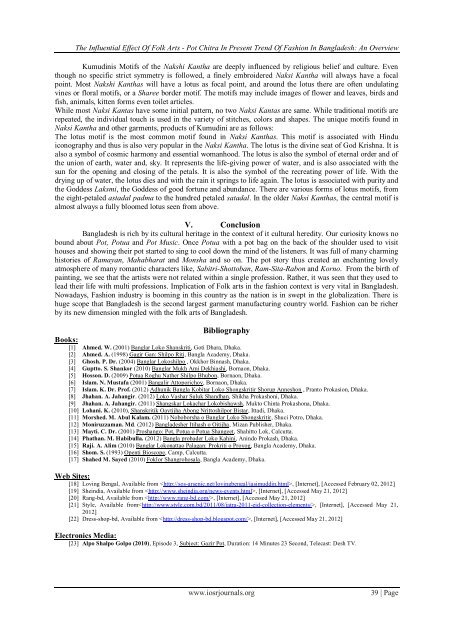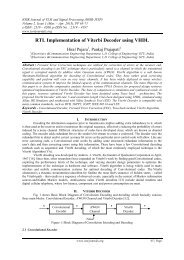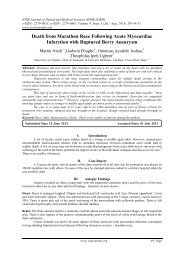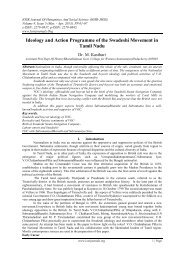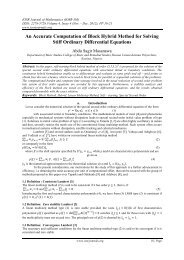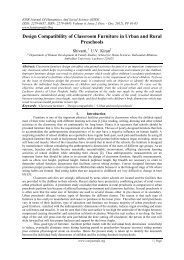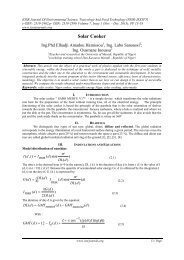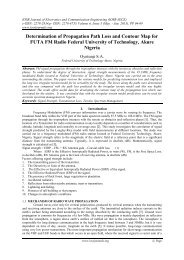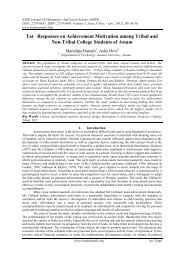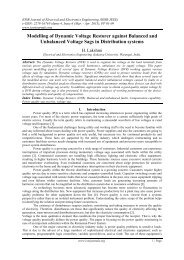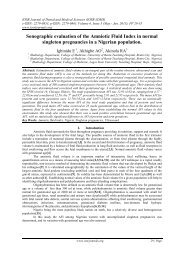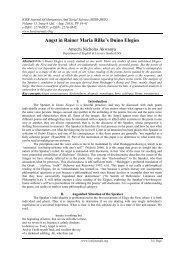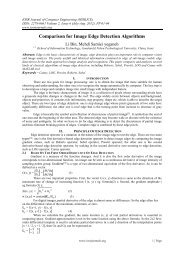Initial Conquest of India by Turks and Their Slaves - IOSR
Initial Conquest of India by Turks and Their Slaves - IOSR
Initial Conquest of India by Turks and Their Slaves - IOSR
Create successful ePaper yourself
Turn your PDF publications into a flip-book with our unique Google optimized e-Paper software.
The Influential Effect Of Folk Arts - Pot Chitra In Present Trend Of Fashion In Bangladesh: An Overview<br />
Kumudinis Motifs <strong>of</strong> the Nakshi Kantha are deeply influenced <strong>by</strong> religious belief <strong>and</strong> culture. Even<br />
though no specific strict symmetry is followed, a finely embroidered Naksi Kantha will always have a focal<br />
point. Most Nakshi Kanthas will have a lotus as focal point, <strong>and</strong> around the lotus there are <strong>of</strong>ten undulating<br />
vines or floral motifs, or a Sharee border motif. The motifs may include images <strong>of</strong> flower <strong>and</strong> leaves, birds <strong>and</strong><br />
fish, animals, kitten forms even toilet articles.<br />
While most Naksi Kantas have some initial pattern, no two Naksi Kantas are same. While traditional motifs are<br />
repeated, the individual touch is used in the variety <strong>of</strong> stitches, colors <strong>and</strong> shapes. The unique motifs found in<br />
Naksi Kantha <strong>and</strong> other garments, products <strong>of</strong> Kumudini are as follows:<br />
The lotus motif is the most common motif found in Naksi Kanthas. This motif is associated with Hindu<br />
iconography <strong>and</strong> thus is also very popular in the Naksi Kantha. The lotus is the divine seat <strong>of</strong> God Krishna. It is<br />
also a symbol <strong>of</strong> cosmic harmony <strong>and</strong> essential womanhood. The lotus is also the symbol <strong>of</strong> eternal order <strong>and</strong> <strong>of</strong><br />
the union <strong>of</strong> earth, water <strong>and</strong>, sky. It represents the life-giving power <strong>of</strong> water, <strong>and</strong> is also associated with the<br />
sun for the opening <strong>and</strong> closing <strong>of</strong> the petals. It is also the symbol <strong>of</strong> the recreating power <strong>of</strong> life. With the<br />
drying up <strong>of</strong> water, the lotus dies <strong>and</strong> with the rain it springs to life again. The lotus is associated with purity <strong>and</strong><br />
the Goddess Laksmi, the Goddess <strong>of</strong> good fortune <strong>and</strong> abundance. There are various forms <strong>of</strong> lotus motifs, from<br />
the eight-petaled astadal padma to the hundred petaled satadal. In the older Naksi Kanthas, the central motif is<br />
almost always a fully bloomed lotus seen from above.<br />
V. Conclusion<br />
Bangladesh is rich <strong>by</strong> its cultural heritage in the context <strong>of</strong> it cultural heredity. Our curiosity knows no<br />
bound about Pot, Potua <strong>and</strong> Pot Music. Once Potua with a pot bag on the back <strong>of</strong> the shoulder used to visit<br />
houses <strong>and</strong> showing their pot started to sing to cool down the mind <strong>of</strong> the listeners. It was full <strong>of</strong> many charming<br />
histories <strong>of</strong> Ramayan, Mahabharat <strong>and</strong> Monsha <strong>and</strong> so on. The pot story thus created an enchanting lovely<br />
atmosphere <strong>of</strong> many romantic characters like, Sabitri-Shottoban, Ram-Sita-Rabon <strong>and</strong> Korno. From the birth <strong>of</strong><br />
painting, we see that the artists were not related within a single pr<strong>of</strong>ession. Rather, it was seen that they used to<br />
lead their life with multi pr<strong>of</strong>essions. Implication <strong>of</strong> Folk arts in the fashion context is very vital in Bangladesh.<br />
Nowadays, Fashion industry is booming in this country as the nation is in swept in the globalization. There is<br />
huge scope that Bangladesh is the second largest garment manufacturing country world. Fashion can be richer<br />
<strong>by</strong> its new dimension mingled with the folk arts <strong>of</strong> Bangladesh.<br />
Bibliography<br />
Books:<br />
[1] Ahmed. W. (2001) Banglar Loko Shanskriti, Goti Dhara, Dhaka.<br />
[2] Ahmed. A. (1998) Gagir Gan: Shilpo Riti, Bangla Academy, Dhaka.<br />
[3] Ghosh. P. Dr. (2004) Banglar Lokoshilpo , Okkhor Binnash, Dhaka.<br />
[4] Guptto. S. Shankor (2010) Banglar Mukh Ami Dekhiashi, Bornaon, Dhaka.<br />
[5] Hosson. D. (2009) Potua Roghu Nather Shilpo Bhubon, Bornaon, Dhaka.<br />
[6] Islam. N. Mustafa (2001) Bangalir Attoporichoy, Bornaon, Dhaka.<br />
[7] Islam. K. Dr. Pr<strong>of</strong>. (2012) Adhunik Bangla Kobitar Loko Shongskritir Shorup Anneshon , Pranto Prokasion, Dhaka.<br />
[8] Jhahan. A. Jahangir. (2012) Loko Vashar Suluk Sh<strong>and</strong>han, Shikha Prokashoni, Dhaka.<br />
[9] Jhahan. A. Jahangir. (2011) Shangskar Lokachar Lokobishawsh, Mukto Chinta Prokashona, Dhaka.<br />
[10] Lohani. K. (2010), Shanskritik Oaytijha Abong Nrittoshilpor Bistar, Ittadi, Dhaka.<br />
[11] Morshed. M. Abul Kalam. (2011) Noboborsha o Banglar Loko Shongskritir, Shuci Potro, Dhaka.<br />
[12] Moniruzzaman. Md. (2012) Bangladesher Itihash o Oitijha, Mizan Publisher, Dhaka.<br />
[13] Mayti. C. Dr. (2001) Proshango: Pot, Potua o Potua Shangeet, Shahitto Lok, Calcutta.<br />
[14] Phathan. M. Habibulla. (2012) Bangla probader Loko Kahini, Anindo Prokash, Dhaka.<br />
[15] Raji. A. Alim (2010) Banglar Lokonattao Palagan: Prokriti o Proyog, Bangla Academy, Dhaka.<br />
[16] Shom. S. (1993) Openti Bioscope, Camp, Calcutta.<br />
[17] Shahed M. Sayed (2010) Foklor Shangrohosala, Bangla Academy, Dhaka.<br />
Web Sites:<br />
[18] Loving Bengal, Available from , [Internet], [Accessed February 02, 2012]<br />
[19] Sheindia, Available from , [Internet], [Accessed May 21, 2012]<br />
[20] Rang-bd, Available from , [Internet], [Accessed May 21, 2012]<br />
[21] Style, Available from, [Internet], [Accessed May 21,<br />
2012]<br />
[22] Dress-shop-bd, Available from , [Internet], [Accessed May 21, 2012]<br />
Electronics Media:<br />
[23] Alpo Shalpo Golpo (2010), Episode 3, Subject: Gazir Pot, Duration: 14 Minutes 23 Second, Telecast: Desh TV.<br />
www.iosrjournals.org<br />
39 | Page


